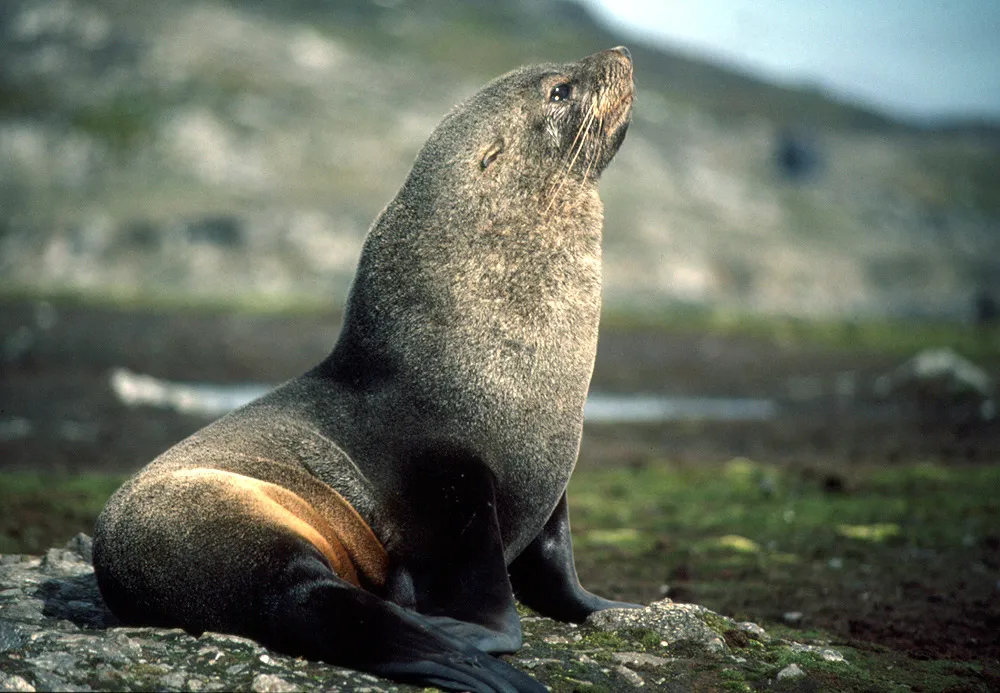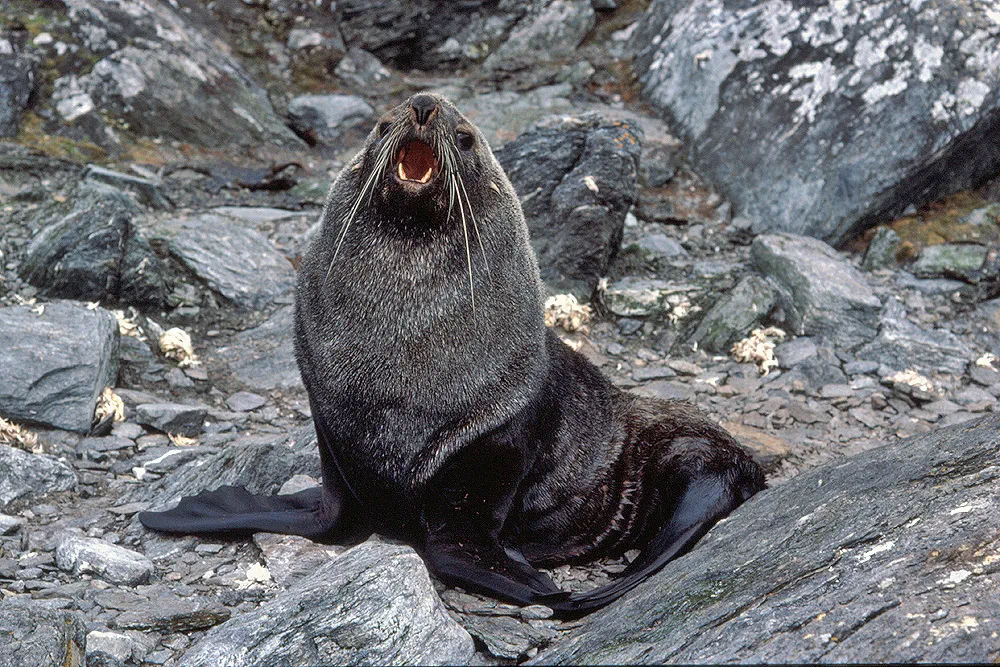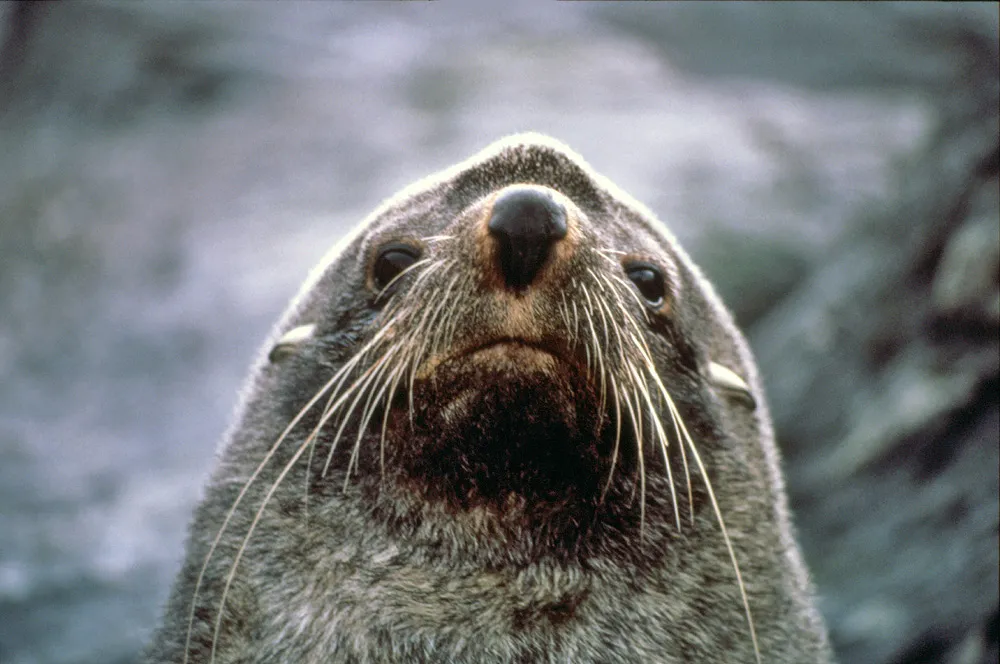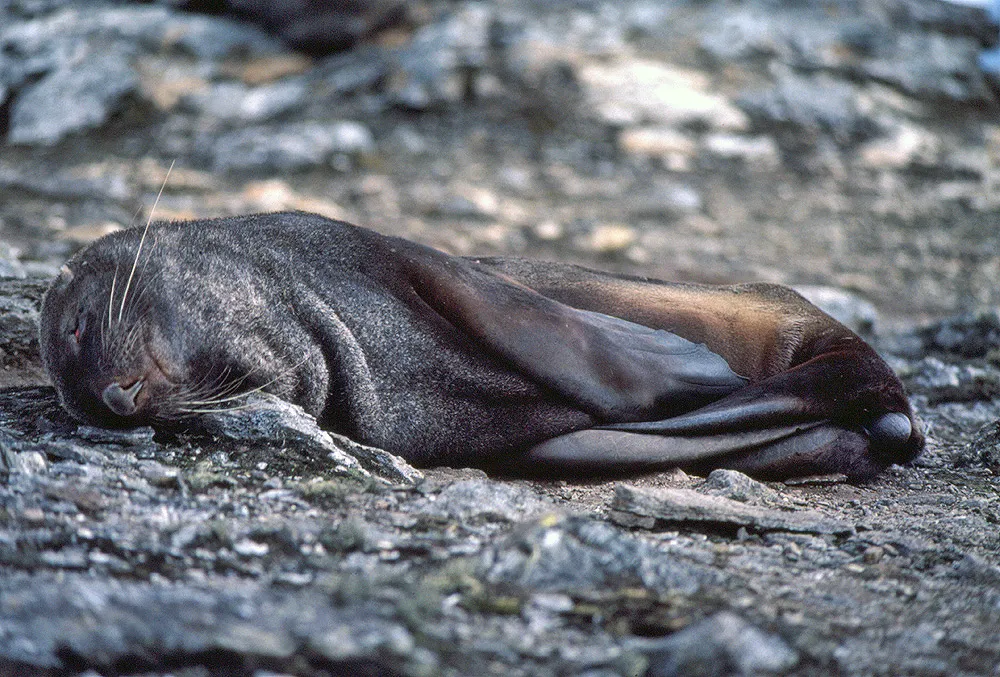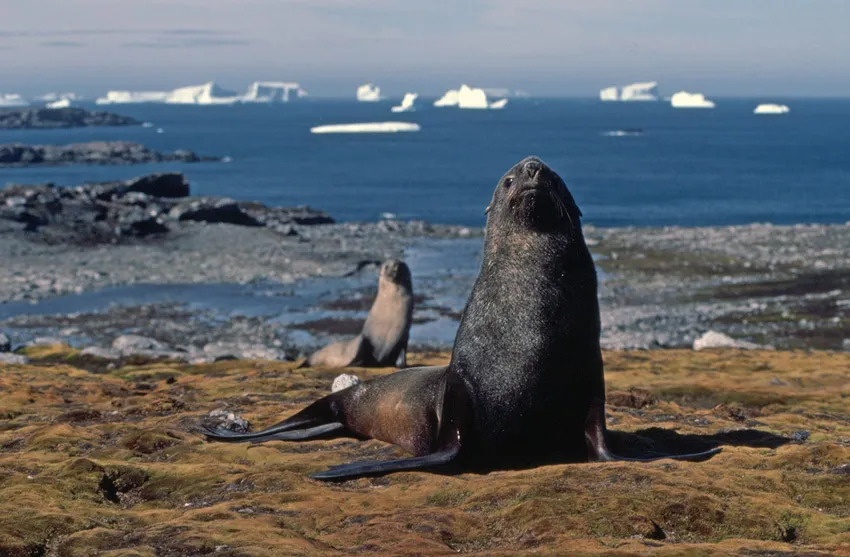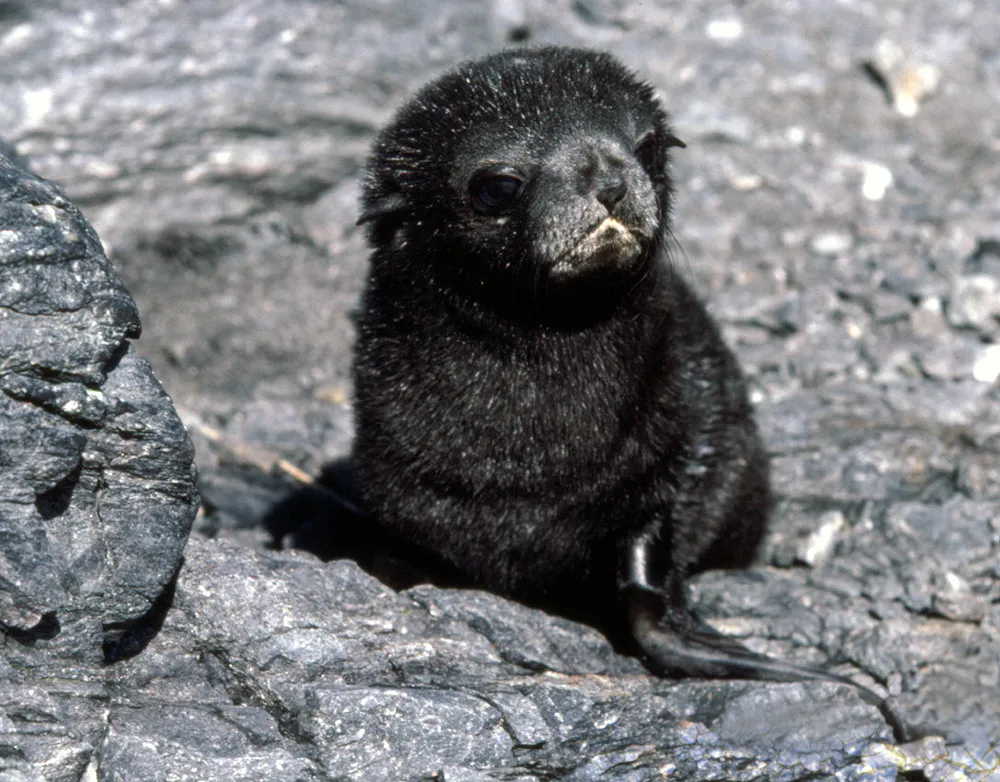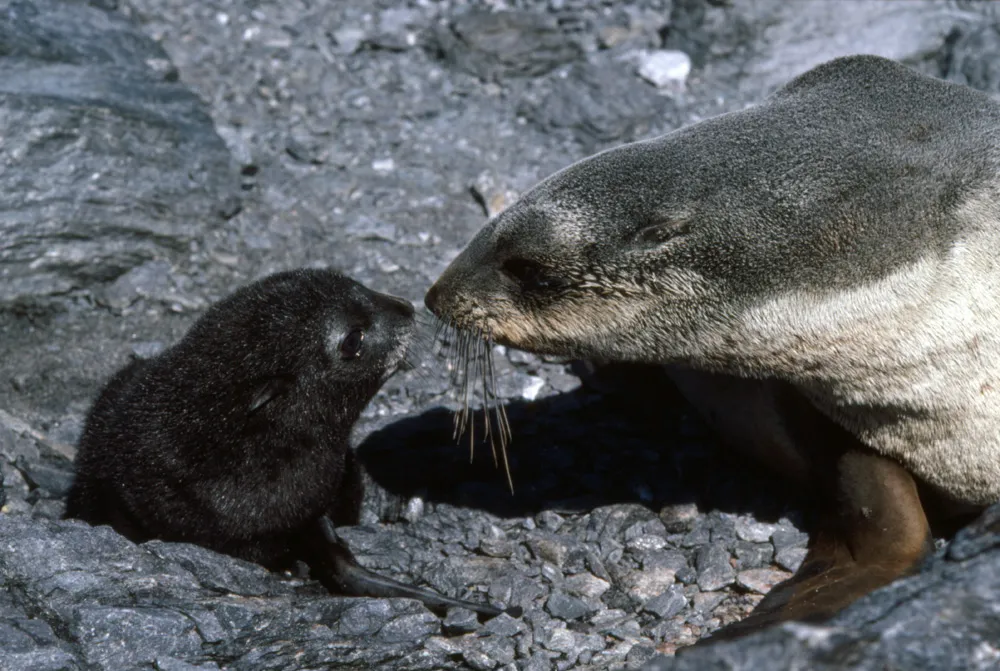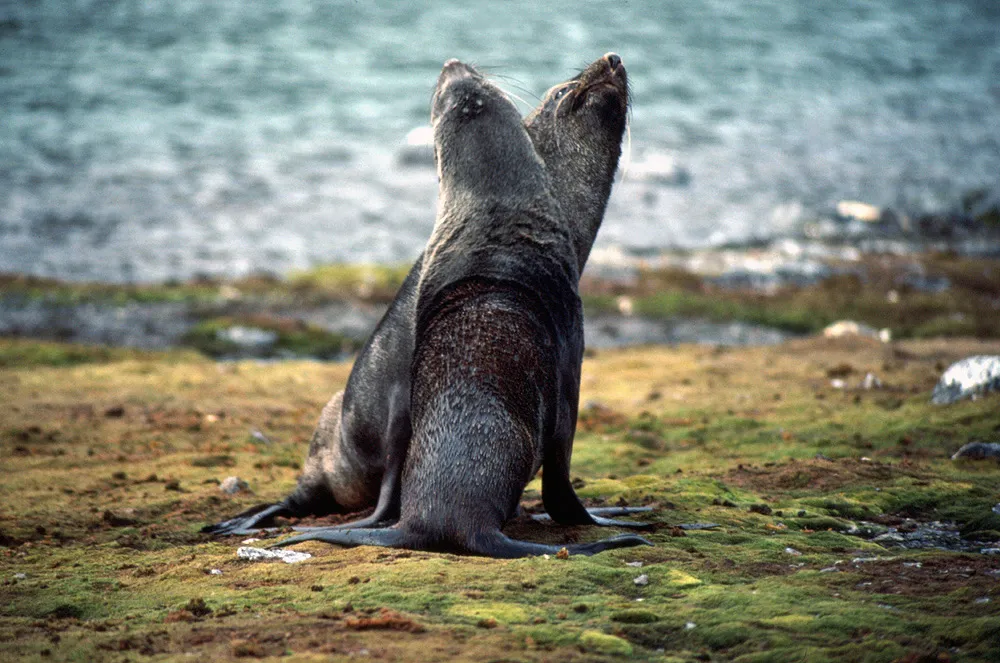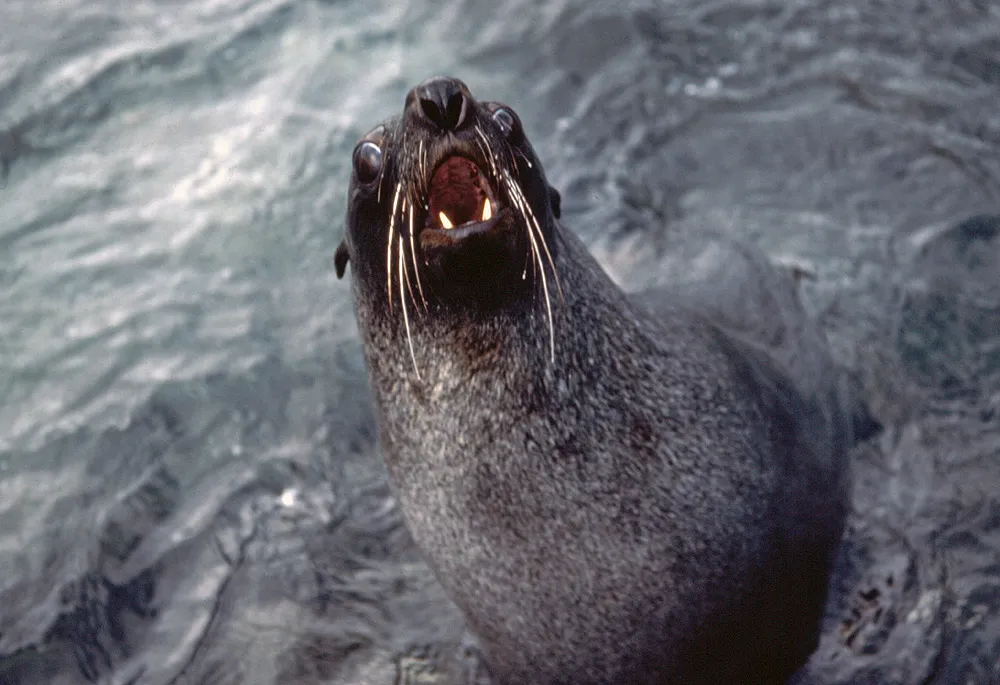Antarctic Fur Seal - Southern Fur Seal
- Arctocephalus
gazella
Once close to extinction, fur seals are restricted mainly to the sub-Antarctic islands, with 95% of the worlds population being found on the island of South Georgia.
Southern Fur Seal Basics
Weight: Males 130 to 210 kg / females
22 - 55 kg.
Length: Males typically
1.8 m / females 1.2 - 1.4 m
Breeding Season:
Females arrive on breeding beaches a day or two before giving
birth in November and December. Males are already in residence
arriving a month or so earlier and have established territories.
The small females stay with their pups for 6-7 days before
returning to sea to feed, they come into oestrus at this
time and mate again, they nurse the pups for about 4 months.
Estimated world population: - 5 to
7.5 million, population increasing.
Feeding
& diet: Fur seals will usually feed on krill where
it is available and then on fish and squid when it is not.
The availability varies with season and with location. They
are also known to feed on penguins to a lesser extent.
Diving: Antarctic Fur seals are not
great divers when compared to other seals, the longest dives
are about 10 minutes, average dives are to 30-40m for around
2 minutes. Most dives are shallower than this when they
do most of their feeding.
Conservation status:
Least concern. Protected by the Antarctic Treaty
and the Convention for the Conservation of Antarctic Seals.
Distribution: Circumpolar where there
are seasonally ice-free islands, they are rarely found hauled
out on ice preferring land. Mainly found just south or sometimes
north of the Antarctic convergence, a sub-Antarctic species
rather than Antarctic.
Predators:
Leopard seals, especially of pups, in the South Shetland
Islands predation levels are thought to be enough to cause
a population decline.
What are Southern Fur Seals like?
Fur seals belong to the group known as the Otarid or "eared" seals, this group contains fur seals and sea-lions that have a visible earflap.
Antarctic fur seals are more accurately called "Southern fur seals". In appearance and manner they resemble a large dog (albeit a funny shaped one). They are able to bring their rear flippers under their body and take the weight of their body on their fore-flippers and so are much more agile on land compared to other Antarctic seals such as elephant, weddell, leopard and crabeaters.
The males can reach 200kg (440lb) and can be up to 4 times larger than the females. They are restricted mainly to the sub-Antarctic islands, with 95% of the worlds population being found on the island of South Georgia.
Endangered Antarctic Fur Seals
In the 1700's and 1800's, fur seals were almost completely wiped out by sealers. Captain James Cook visited the island of South Georgia in 1775 and reported that there a great many seals present. This led to sealers setting sail to bring back the pelts of these animals. They were very popular for their dense short fibred fur that was made into ladies coats.
Within 25 years of being discovered, the catch for a single summer was 112,000 animals. By 1822, the southern fur seal was virtually extinct on South Georgia. Ironically, it was the quest for new populations of fur seals that led to much of the early exploration of Antarctica and the Southern Ocean.
By the beginning of the 1900's the southern fur seal was a rare animal indeed, a single male was sighted on South Georgia in 1916 and duly killed.
The rest of the fur seal story is much happier. In 1931 a scientific expedition discovered a small breeding colony of a few hundred on Bird Island (just off the coast of South Georgia).The decline of the fur seal coincided with the rise of whaling. Baleen whales and fur seals both feed on the same food - krill. As the whales were slaughtered in ever increasing numbers so there was ever more krill available for the fur seals to feed on.
By the end of the 1950's the world population of fur seals stood at about 5 000, by 1976 on South Georgia alone it had reached 100,000. In 1993 the estimated population was around 1.5 million with more and more seals being found further away from South Georgia and beginning to breed further afield too. The population in 2015 is estimated to be between 5 and 7.5 million though this is in part based on projected earlier figures.
So altogether this is a story of a remarkable come-back almost from the brink of extinction to one of a very large and healthy population of these wonderful creatures.
How do the mothers care for their young?
Fur seal pups weigh about 5-6 kg (11 - 13lb) at birth, unlike some other Antarctic seals, the females feed regularly while they are suckling rather than surviving on fat reserves until the pup has grown quite large.
A new mother will stay with her pup for 6-7 days after birth before she goes back to sea to feed again, fishing trips last between 3 and 6 days so the growth of a young fur seal is rather irregular and weaning happens later than with other species at around 4 months. The pups are quite mobile from an early age and have the "don't mess with me" demeanour of a terrier towards anything larger than it.
Why are the males so much bigger than the females?
When one sex is different to the other, this is known as "sexual dimorphism", this may be in appearance or or of size.Seals spend much of the year swimming through the seas fishing as they go, while they may spend time with other seals, they do not form strong bonds with a partner to rear their young.
When born, the young are fed only on milk by the mother and soon learn to fish for themselves. Birthing usually takes place on a beach with many other seals and the female comes into oestrous (i.e. is ready to mate again) shortly after giving birth.
Because of this life-style, many seals have evolved a strong sexual dimorphism. The males arrive on the birthing beaches a month of more before the females and fight to establish and defend their territories. The most successful male, known as the "beachmaster" gets to mate with as many as a hundred females that are in his territory.
Therefore there is a great advantage to being big and strong, and if a male is not among the biggest and strongest, he will not get to mate at all. This has led to a pronounced sexual dimorphism. The females while getting no help to rear her young is guaranteed to have the biggest and strongest males father her children.
Are these seals as agile as they look?
Fur seals are very agile partly because of the arrangement of their flippers, and partly because being essentially sub-Antarctic seals, they don't have as much blubber as other types.They have a surprising turn of speed out of the water and can venture some distance inland. A first encounter with fur seals, particularly if there are lots of them, is often very disconcerting. They begin by making a plaintive "pouff pouff" sound as you get closer and they notice you and then may make a short charge and lunge, this can be rather worrying!
Once you get used to them however, they are great characters and great fun, like having big bouncy dogs about that want to have fun but aren't really sure of whether you do, or if you might be a threat. They still have to be treated with respect though a bite would be especially unpleasant as they have a particularly rich and unpleasant bacterial collection that live in their mouths.
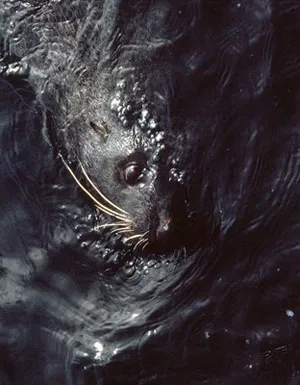 "Sealers
finger" was a common affliction in the bad old days when a sealer
got too close, the resulting infection would often mean the
loss of the use of that finger (serves 'em right!).
"Sealers
finger" was a common affliction in the bad old days when a sealer
got too close, the resulting infection would often mean the
loss of the use of that finger (serves 'em right!).
These two pictures come from one afternoon when I was walking along the sea-shore where there were young fur seals. This particular seal followed me for about 20 minutes or so as we played a game of peek-a-boo, him in the sea and me behind the rocks. He might look a bit manic, but it was all great fun.
I'd hide behind a rock and he'd wander up and down making the "pouff-pouff" sound then I'd jump out from the rock and he'd leap into the sea in mock panic. A couple of powerful strokes of the flippers and he'd turn back round, shoot out of the sea and land virtually at my feet - my turn to leap away in (not always mock) panic. A wonderful experience with a totally wild animal and one of many that I had with fur seals.
Another favourite memory is of playing chase on my hands and knees in soft snow with a young seal, going back and forth to each other. Wonderful animals! Can't have enough of them!

